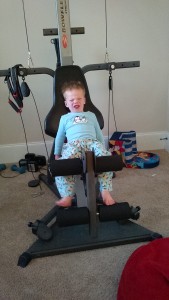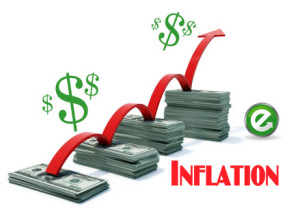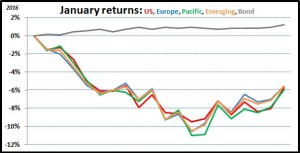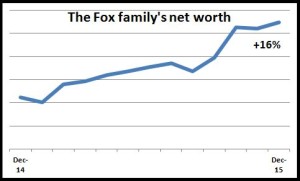Normally I write about personal finance and the stock market. However, due in some part to the fact that I have a lot of free time since I don’t have a real job, I was thinking about posts on the weekends that look at other parts of society that interest me. I’m a huge sports fan, so let’s take a Stocky-Fox look at college football and men’s college basketball.

College sports has a hallowed place in American culture. Wait a second, let’s be honest with ourselves, really two college sports have a hallowed place in American culture—football and men’s basketball. ALL the others fall significantly short when you look at basic metrics to gauge popularity and importance—the revenue they generate, the fans that attend the events, the coverage they get on ESPN, the Facebook posts/Tweets they get, etc. I am willing to concede that in certain geographies men’s hockey, men’s baseball, and women’s basketball are quite popular, but even then they tend to be small potatoes compared to football and men’s basketball. So for the sake of this post, let’s focus on the two biggies. Unless I say otherwise, when I refer to college sports in this post, I am specifically meaning football and men’s basketball.
I am a huge college sports fan, but I am also extremely conflicted. Some of my fondest memories growing up with my dad revolved around college sports—picking our basketball brackets, watching New Year’s Day bowl games on TV, going to University of Redlands basketball games, to name a few.
But the state of college sports is shameful, and has always been. Just recently the University of Louisville, bear in mind I went to high school in Louisville, just put its men’s basketball team on probation because of a scandal involving prostitutes and recruits. A couple years back the University of North Carolina, bear in mind I just moved to North Carolina, got in hot water for a pretty extensive academic fraud where the basketball players weren’t going to class. A few years before that USC’s football team had to vacate their Heisman trophy and national championship because of allegations of paying players, bear in mind we just moved from Los Angeles. And there’s a million others—sexual assaults, point shaving, physical assault, drug abuse, steroid use, and on and on and on. Year after year after year. Are these the types of institutions and people our society should place on pedestals? If I am watching them play, aren’t I complicit in that pedestalization?
I want to take this post to objectively look at the pros and cons of big-time college sports. As you read this, I would love to hear what you think.
What is the role of higher education?
First and foremost, we need to decide what we want colleges and universities to do. Is it to educate students in subjects like math, science, history, and literature? Teach life skills? Prepare them for gainful employment? Expose them to a diverse world? Offer an opportunity to explore their interests? Provide really fun times?
For non-athletes, the only one of those that sports at their school meets is the “provide really fun times”. Let that sink in for a second. College sports, which is a huge deal across the country, benefits the vast majority of students by providing “fun”. For all the time and effort and money that surrounds the issue we’re talking about, that’s the benefit to most. That doesn’t really seem to align with the mission of higher education, but maybe it should. More on this a bit later.
For athletes it’s a bit more complex. College sports has nothing to do with educational subjects. Nor does it have to do with exploring interests; only in the rarest of circumstances does a guy go to college and say “let’s try basketball out. I always wanted to do that.”
For a very, VERY small fraction of athletes it does prepare them for gainful employment in a professional football or basketball league. However, you could also argue that too many college athletes who don’t have the skills to be professional athletes might dedicate too much effort chasing that professional dream that will never materialize. That said, let’s agree that for the best athletes, college is an important place to prepare for future employment, just like it is for non-athletes.
The big one in my opinion is the life skills piece. Whether you go pro or sit the pine, being on a team offers great opportunities to grow and mature as a person. Admirable qualities like dedication, commitment, teamwork, humility, pride, achievement, and many more are very available for any athlete who is open to accepting them. But remember, only the athletes benefit from this, not the larger student body.
So there you go, when you look at the role of higher education and its intersection with college athletics, it really seems to boil down to the life skills that athletes are getting, with a small element of job training for the most gifted athletes. And non-athletes get bupkis (except maybe some really good times).
Supporting all the other athletic programs
To the degree that you believe in that “life skills” argument for the athletes then you have to support college football and basketball. Why? It’s a simple answer—MONEY.
Those two programs (and football much more so than even men’s basketball) generate the money that pretty much supports every other sport. Just as an example at the UofL, since they’re in the news, the two big programs generate a ton of money, about $2 million of which goes to the other athletic programs.
Other sports like gymnastics, swimming, volleyball, and on and on—none of those could exist without the largess from football and men’s basketball. All of those are money losers. What funds them? You have two choices: either your football and men’s basketball programs, or you can pay for them by the general funds of the university.
So let’s say you’re fed up with football and men’s basketball because of all the crap. You can shut down your athletic program, or you can pay for it by using funds that could otherwise go to student housing, scholarships, research, or (try not to laugh) lowering tuition. How important is gymnastics or lacrosse or wrestling?
Women’s sports
I could have mentioned this in the “pay for other athletic programs” category, but women’s sports deserves its own section. In 1972 Title IX was passed into law which basically equalized college sports for men and women. It required that the same amount of money be spent on women’s sports as men’s, and that the same number of athletic scholarships be given to women as men.
This was a huge boon for women’s athletics, as you can imagine. The number of sports that schools offered for women increased because they had to even out things with their men’s programs. Football teams are allowed 85 scholarships, so that has to be matched by 85 scholarships for women’s programs. Just using round numbers, that means the football program is balanced out by the women’s swimming, gymnastics, field hockey, soccer, and softball. Not bad.
But let’s be honest with ourselves. The only reason Title IX was possible was because football and men’s basketball were so profitable. You can’t really tax those programs in a traditional sense, so really the only way that society could dictate where that money went was by forcing a “gender equality” gambit on them. And by most standards it’s been a huge win. Football and men’s basketball get to continue to do their thing and now there is a whole generation of women athletes who get to participate in collegiate athletics and get all those life-skill benefits it provides.
But make no mistake, without college football and basketball, women’s athletics are dead meat.
Students who wouldn’t otherwise be there
Football and men’s basketball is often a path to higher education for many students who would otherwise never be able to attend college. The number of young men who parlayed their athletic abilities to get a higher education is countless. And that’s important. Undeniably college sports has taken men who would otherwise be blights on society and given them the opportunities to get an education and become contributing members of society.
This is especially true for poor students and black students (who statistically tend to be poorer). There are a million examples, but a good one is Georgetown University. It is an extremely highly-regarded, extremely expensive private school in Washington DC. The total student body is about 6% black.
It also has one of the most storied men’s basketball program in the nation, thanks to the legendary coach John Thompson (who I think is best basketball TV analysts out there and I wish he would do more games). The starters for the basketball program for the past several decades are probably about 90% black. A student body that is 6% black with a basketball program that is 90% black. How many of those black students would be going to Georgetown if it wasn’t for basketball? Probably not many.
Of course that’s good for the students, but that’s also good for the university. Isn’t college supposed to offer that type of exposure to diversity? Probably a lot of that goes away if one of the main avenues for “different” types of students to attend the school goes away.
What really matters to college students?
If you’re a non-athlete student going to college, what are the things that are really important? In a lot of ways college is a bit of a commodity. The calculus you learn at UofL is the same I learned at Pitt. Biology is the same, accounting, English literature, mechanical engineering, and on and on. Sure, there might be slightly nuanced approaches to teaching the subjects. And definitely the professors can make a huge difference, but every college has their share of good and bad teachers. There are some schools that truly offer coursework that no other institution offers, but those tend to be the exception.
There’s the campus as well. Is it idyllic like Centre College in the middle of nowhere in Kentucky? That can be really nice and peaceful, allowing the student community to really forge strong bonds on their “academic island”. Is it an urban campus like I had at Pitt, allowing us to embrace the city of Pittsburgh and all it had to offer? Those are differences.
Also, there are the amenities on campus: the niceness of the student housing, the food court, workout facilities (probably funded by the athletic programs).
We haven’t mentioned fun yet. When you’re a student what are you doing for fun? Sure there’s a ton of things, much of which involves beer and bad decisions regarding sex. One of the main sources of fun for a very large part of the student body is football and men’s basketball. There’s tailgating, going to the game, celebrating the wins, and getting collectively pissed at the refs who robbed your team of the game in the loses. Unquestionably, there are a lot of students who couldn’t care less, but there isn’t another school activity that brings more students together than college sports.
What really matters to alumni?
As important as college sports is to the students while in school, they become even more important to an even larger part of the alumni after they leave school. Just look at the vernacular: “Homecoming”. That is when alumni come back home, come back to campus. And what is the centerpiece of “homecoming”—it’s a football game.
As a Pitt alumni I try to be involved in recruiting and mentoring, but it’s pretty hit or miss. You want to know what connection I consistently have to Pitt—getting together with local alumni to watch the football games each Saturday (I did this in LA, but now that we’re in Greensboro, surprisingly, the Pitt network isn’t as strong).
I couldn’t tell you the number of Rhodes Scholars that Pitt had or the amazing patents their research institutions have filed. I have no idea who the most influential lawyer or innovative entrepreneur or life-saving doctor is. You want to know what I do know? The football team had a decent season and lost to Navy in their bowl game. The basketball team is middle of the pack in the ACC and will probably miss the tournament. And that is going to be the same for 98% of the alumni out there.
Being entertaining as hell
College athletics can reasonably be seen as an entertainment product. How many other things do you know that can pack a stadium with 100,000 people, have fans camp out for tickets, drive a huge Nielsen rating on television, and bring a local community together? Not many. So that’s a good thing.
People who are disdainful about sports because of all the bad apples are surely entertained by something. If not sports then opera or theater or movies or concerts or something. College athletics in many ways is just that, a really entertaining product.
Our entitlement society
Now we’re at the crux of the issue, all the bad behavior. Prostitutes, skipping classes, drugs, alcohol, and all sorts of other bad things. Of course, all those things are pretty common on college campuses, whether involving athletes or non-athletes. The problem comes in with the difficult-to-wrap-your-arms-around idea that college students represent the school and should be held to a higher standard. That’s a tough one to hold them up to a higher standard and punish them when they do the same things other students do. A huge plank of the anti-college athletics argument is “fairness”. Where is the fairness of holding college students to a higher standard?
When athletes do break the rules, there’s the perception that they get treated with more leniency than an ordinary student, and that is most certainly true. But why should we be surprised? That is society. How many rock stars or actors or politicians act like absolute assholes but society turns a blind eye because they are famous? Justin Bieber, Ted Kennedy, Hugh Grant, and on and on.
Why should it be different for a similarly talented person, but their talents are putting a ball through a hoop instead of writing a catchy tune? Now the optimist will say we shouldn’t allow that all. Every person should be held to the same rules. I agree with you. But we don’t live in that world. Let’s be realistic. That is a problem bigger than college athletics, that’s a problem with fame.
But it’s fair to say why should colleges tolerate these bad guys on their teams, knowing that these misbehaving athletes will be the face of the university. The short answer: WINNING. We live in an entitlement society and athletes enjoy those entitlements. The better of an athlete you are, the more entitlements you receive. And any economist will tell you that without repercussions for bad behavior, people will behave badly. It’s that simple and that’s what’s happening with college athletics.
Sure, there are sterling examples of good athletes. Grant Hill comes to mind as a superstar college athlete who was a genuinely good guy and didn’t get in trouble. So does Peyton Manning . . . except that would have been true two weeks ago. Now there are allegations that he sexually assaulted a female athletic trainer when he was at University of Tennessee. Of course, you don’t have to go very far to find the athletes who are bad guys.
Can a college exist without sports?
So what’s a school to do? We probably need to accept that in the foreseeable future if you want a winning college athletic program, you have to get athletes who have a certain amount of unsavoryness to them. Suggesting otherwise is just putting your head in the sand.
Maybe some should follow the University of Chicago’s example (I went to UofC to get my MBA, incidentally). Back in the 1930s and before Chicago was a sports powerhouse. They were a founding member of the Big 10, won the first Heisman trophy, fielded a football program that competed against the Chicago Bears on the Midway (the Midway is a park on the UofC campus; ever wonder how the Bears got their nickname “Monsters of the Midway”?).
They gave it all up. In 1939 they abolished their football program and in 1946 they left the Big 10. As you might expect, their athletic program descended into obscurity. They are now a Division III school. Their football stadium and basketball areas seem like small high school facilities. Why would a school give it all up?
They wanted to focus on academics. Wait?!?! What?!?! A university wanted to focus on academics at the cost of their athletics program. Hard as it may be to believe, it’s true. Chicago is now widely considered one of the premier research universities in the world. Their student body is one of the smartest. It’s also one of the nerdiest and least fun. There are t-shirts that boast “UofC: Where fun goes to die”. And there’s a lot of truth to that. There are no football bonfires, no big games that bring the school together, no championship banners, no alumni events centered on a great gridiron victory.
The choice is there. A school can focus on academics and rid itself of the collateral damage that comes with it, that comes at a major cost. Which schools are willing to do that? To my knowledge, Chicago is the only school that deliberately destroyed such a strong athletic program for the sake of staying true to its academic mission.
What to do? What to do?
If you look at all this, it’s a tough call. Football and college basketball are fairly filthy, but a lot of good comes from that filth. Support for all the other athletic programs, including women’s sports; greater diversity on campus; fun and a sense of university community; entertainment for the masses. Do you give all that up, like the University of Chicago did, just to rid yourself of the filth?
My answer is “no”. I hate that football and men’s basketball programs are so despicable and drive a double-standard. But to me the good outweighs the bad. Just like in society at large, you have to take the good with the bad, and college football and men’s college basketball are no exceptions.














